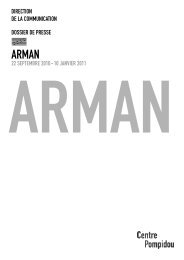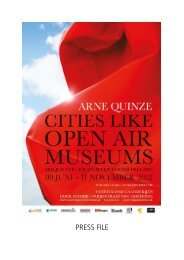Arman - Vicky David Gallery
Arman - Vicky David Gallery
Arman - Vicky David Gallery
You also want an ePaper? Increase the reach of your titles
YUMPU automatically turns print PDFs into web optimized ePapers that Google loves.
7<br />
3. BIOGRAPHICAL HIGHLIGHTS<br />
<strong>Arman</strong>d Pierre Fernandez is born in Nice on 17 November 1928. His father Antonio Francesco Fernandez,<br />
Spanish by origin, is the owner of a furniture shop. The family lives in the Rue Maréchal Joffre in Nice,<br />
and <strong>Arman</strong>d spends his childhood in the composite universe of the second-hand shop, from whence would<br />
come his taste for collecting. His father, an amateur painter, teaches him the techniques of oil painting<br />
and takes him to the universal exhibitions of the day: the young boy is fascinated by the machines cut down<br />
the middle to reveal their inner workings. He quickly reveals himself to be artistically gifted and persuades<br />
his parents to allow him to study at the École Nationale des Arts Décoratifs in Nice. Although a brilliant<br />
student, he leaves the school in 1949, exasperated by its conservatism.<br />
1947-1950<br />
<strong>Arman</strong>d meets Yves Klein and Claude Pascal at the judo school run by the Nice police. Under Klein’s<br />
influence, the three interest themselves in esoteric teachings and find themselves fascinated by the pure<br />
colours and violent technique of Vincent Van Gogh. Out of admiration for the latter, Yves and <strong>Arman</strong>d decide<br />
to use only their first names in signing their work. In 1948, <strong>Arman</strong>d discovers the leading figures in<br />
Dada and Surrealism, who will influence his work as a painter. In 1949, he moves to Paris to enrol at the<br />
École du Louvre. His friendship with Klein and Pascal does not suffer: together they form the Triangle<br />
group.<br />
1951-1959<br />
<strong>Arman</strong>d is given an entrée into Parisian artistic circles by Yves Klein and his mother Marie Raymond, who<br />
introduces him to Anna Staritsky, who points him towards non-figurative painting. He discovers the work<br />
of Hendrik Nicolaas Werkman, a Dutch typographer (d. 1945) who had used mechanical repetition in<br />
word-based typographical compositions. In Paris he is impressed by the paintings of Jackson Pollock’s that<br />
he sees at Studio Facchetti, which will influence both the spirit and the composition of his own work.<br />
On 17 February 1953, he marries Éliane Radigue; he works as a salesman in his father’s shop. His painting<br />
becomes abstract, showing the influence of Poliakoff and Nicolas de Staël. In Paris in spring 1954 he<br />
discovers Kurt Schwitters, being strongly influenced by his rubbish and fragments of paper, whose abstract<br />
play of forms and colours breaks with the post-Cubist order. Back in Nice, he takes the rubber stamps<br />
routinely used in his father’s business and uses them in his own work as an artist, more interested in the<br />
formal properties of the stamp than its content. <strong>Arman</strong> shows his Cachets in Paris in 1956 and the press<br />
speaks of Neo-Dada influence, highlighting their formal character. On the occasion of the artist’s first<br />
one-person show (Galerie La Roue, Paris, June 1957), Pierre Restany, whom <strong>Arman</strong> is beginning to<br />
associate with on a regular basis, hails the development of this “viscerally painterly” young man. In 1957<br />
a printer’s error sees his name on a poster curtailed to “<strong>Arman</strong>,” and he decides to exploit this accident and<br />
abandon the final “d” in his forename – and his artistic signature. Yves Klein’s exhibition “Le Vide” opens<br />
at Iris Clert’s on 28 April1958. In May, the same gallery shows recent painting by <strong>Arman</strong> under the title<br />
“Les Olympiens.” Through his wife, <strong>Arman</strong> meets those involved in Groupe de Recherches Musicales (GRM)<br />
run by musician and electrical engineer Pierre Schaeffer, who has just invented ways of slowing down or<br />
stretching out sound, calling the result “Allures d’objets en musique” (the gait of objects in music). <strong>Arman</strong><br />
borrows the name from him, and embarks on his Allures d’objets (Gait of Objects works), which will lead<br />
on to the first Colères (Rages) and Accumulations. In 1959, hen makes his first Poubelles (Garbage Cans)<br />
and meets Martial Raysse.<br />
1960-1962<br />
On 16 April 1959, the Galleria Apollinaire in Milan opens an exhibition of work by Yves Klein, Jacques<br />
Villeglé, Jean Tinguely, Raymond Hains and François Dufrêne, together with Allures-Colères by <strong>Arman</strong>.<br />
In his introduction to the catalogue, Restany makes use of the phrase “New Realists” for the first time.<br />
This essay represents the first manifesto of the future movement, declaring the emergence of a new way<br />
of looking at urban, industrial society, its products and its refuse. In June 1959, Alfred Schmela in<br />
Dusseldorf presents <strong>Arman</strong>’s “Poubelles et Accumulations” which gains a Europe-wide response. For<br />
the occasion, <strong>Arman</strong> writes for the Zero group the text “Réalisme des accumulations,” in which he explains<br />
that the object has a value in itself, and that accumulation allows it to be recontextualised with itself. In<br />
October 1960, Iris Clert presents “Le Plein,” or “Full Up,” <strong>Arman</strong>’s response to Klein’s “Vide.” The invitation<br />
to the opening takes the form of a sardine tin filled with rubbish, containing a short text by Pierre Restany,<br />
who claims that this event brings to New Realism “its properly architectonic dimension.” <strong>Arman</strong> begins<br />
the series of Portraits-robots with portraits of Yves Klein and Iris Clert, gathering some of their personal




